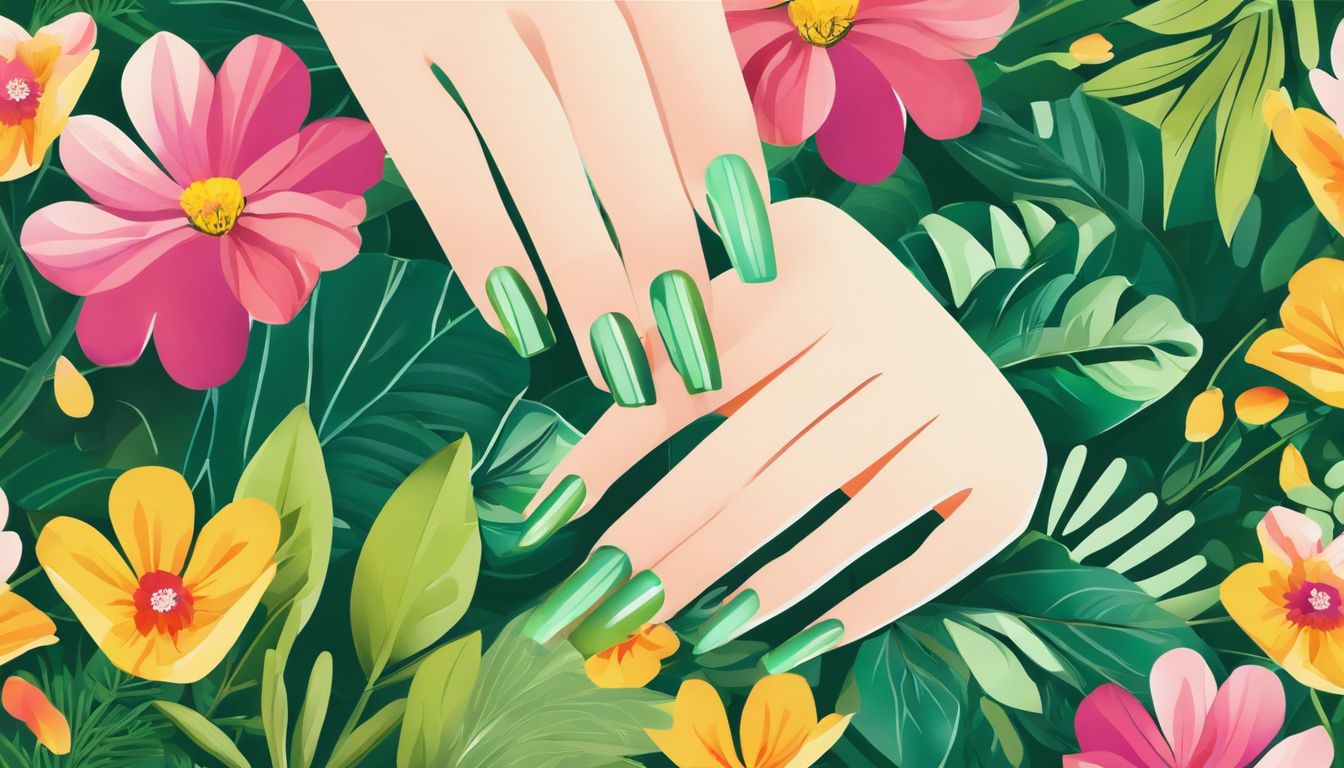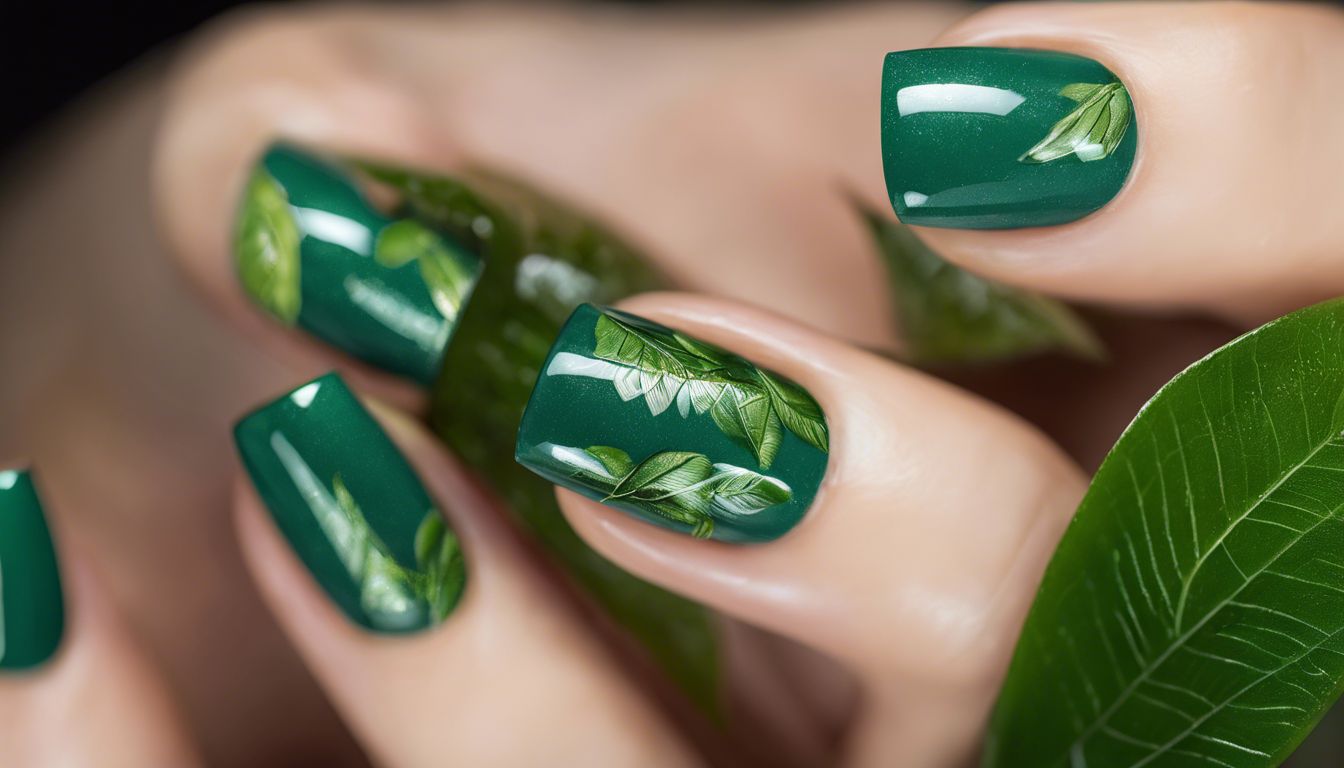Randy Charles is the owner of PaintCentric.com, a website dedicated to providing information, tips, tricks, and news about all things paint. With over 10 years...Read more

Coming across a greenish tinge on your nails can definitely catch you off guard, stirring up worries about the health of your nails. We get it — that unexpected green hue isn’t a welcome sight.
In our quest for answers, we dove headfirst into research to demystify this occurrence and unearthed trustworthy methods for tackling pseudomonas nail infections without having to sacrifice our beauty regimes.
Understanding “Green Nails” or Pseudomonas
Pseudomonas nail infections, also known as green nails syndrome, are caused by the bacteria Pseudomonas aeruginosa. These infections can occur when the nail plate is damaged or in moist environments, leading to a buildup of bacteria and resulting in discoloration of the nail bed.
Recognizing the symptoms of green nail syndrome is crucial for proper treatment and prevention strategies.
What Causes Pseudomonas Nail Infections?
Green nails often come from a sneaky germ called Pseudomonas bacteria. These germs love warm, moist places like under fake nails or between the nail and skin. When we put on artificial nails or acrylics, tiny spaces can trap water.
This gives the perfect spot for these bacteria to live and turn our nails green.
If your hands are in water a lot or if you get a nail injury, this also makes it easier for those germs to set up shop. Now that we understand how these infections start, let’s look at what happens if you cover them with polish.
Recognizing the Symptoms of Green Nail Syndrome
Now that we know what can cause Pseudomonas nail infections, let’s talk about how to spot them. Green nail syndrome shows up in certain ways. Here is a list of symptoms to look out for:
- Nail color changes: Your nail might turn green, blue-green, or have spots of these colors.
- Nail separation: The colored nail may start to lift off the nail bed.
- No pain at first: Usually, the color change doesn’t hurt when it first starts.
- Bad smell: There could be a strange smell coming from the infected nail.
- No cuts needed: The green color shows even if there’s no injury to the nail or skin nearby.
- Long-term problem: If not treated, this color change can last for a long time.
Risks of Covering Green Nails with Nail Polish

Covering green nails with nail polish can create a sealed environment that may exacerbate the bacterial infection, as it does not eliminate oxygen or prevent further spreading of pseudomonas.
The Myth of Oxygen Eliminating Pseudomonas
We often think that if we cover something up, it stops growing or goes away. This is not true with the bacteria called Pseudomonas, which causes green nails. People might believe putting nail polish on a green nail will cut off oxygen and kill the bacteria.
But this isn’t right! Pseudomonas can live without air too.
Actually, these germs like places where there’s no air. If you put fake nails or polish over green nails, it makes a space without air under the nail. The germs find this perfect for growing even more and can turn your nails darker green.
Potential Complications from Sealing in Bacteria
Sealing in bacteria by covering green nails with nail polish or acrylic can lead to potential complications. The trapped moisture and lack of oxygen create an ideal environment for bacterial growth, worsening the infection.
It can exacerbate the Pseudomonas nail infection and delay recovery. Moreover, sealing in the bacteria not only hinders proper treatment but also increases the risk of spreading the infection to other nails, prolonging discomfort and impacting overall nail health.
Seeking professional medical advice is crucial before considering any cover-up solutions for green nails. Proper diagnosis and treatment ensure effective management of Pseudomonas nail infections and prevent further complications associated with bacterial growth under sealed environments.
Proper Treatment for Pseudomonas Nail Infections
Proper treatment for Pseudomonas nail infections includes seeking professional medical advice if the infection is severe or persistent. Home remedies such as vinegar soaks, rubbing alcohol, tea tree oil, and hydrogen peroxide may also help in treating mild cases.
It’s important to practice good nail care habits and prevent the spread of the infection to avoid complications.
When to Seek Professional Medical Advice
If you notice any changes in the color or texture of your nails, such as green discoloration, it’s important to seek professional medical advice promptly. This is especially crucial if you suspect a pseudomonas nail infection.
Home Remedies and Prevention Strategies
We have some tips and tricks for you to help with Pseudomonas nail infections:
- Try soaking your nails in a mixture of 1 part white vinegar and 4 – 10 parts water. Vinegar can help eliminate the Pseudomonas bacteria causing the infection.
- Consider applying a diluted solution of chlorine bleach (1: 4 ratio with water) to your affected nails. This can help suppress the growth of Pseudomonas aeruginosa.
- When dealing with green nail syndrome, it’s essential to keep your nails dry as much as possible. Avoid wet work and briefly soak the affected nail in diluted sodium hypochlorite.
- Remember that removing any artificial nails is an important step in treating Pseudomonas infections. Disinfect the natural nail afterward to ensure all bacteria are eradicated.
- Think about using topical treatments such as ointments containing clotrimazole or oral antibiotics prescribed by a healthcare professional for severe cases.
- Be sure to embrace safe and sanitary nail care practices during recovery, avoiding acrylic nails, press-on nails, or nail enhancements until the infection has cleared completely.
Safe Nail Care Practices During Recovery
– Avoid using traditional nail polish and opt for antimicrobial or antibacterial alternatives to prevent reinfection of the affected nails. Consider embracing natural nails for a period to promote overall nail health and minimize the risk of further complications.
Embracing Natural Nails for Health
We understand the worry and concern about nail health, especially after dealing with Pseudomonas nail infections. Embracing natural nails for health is essential during recovery. Avoid using artificial nails or traditional nail polish, as they can hamper the healing process.
Instead, consider alternatives such as water-based or breathable nail polishes that allow oxygen to reach the nails. Prioritize proper nail care while allowing your nails to rejuvenate naturally.
It’s crucial to give your nails time to heal and breathe following a Pseudomonas infection. Let’s explore safe practices for nurturing healthy natural nails post-infection in our next section on “Safe Nail Care Practices During Recovery”.
Conclusion
In conclusion, painting over green nails caused by Pseudomonas can be safe with proper preparation and cleaning. It is crucial to be cautious and prioritize nail health when considering covering green nails with polish.
Seeking professional advice for treatment and following safe nail care practices during recovery are essential steps towards maintaining healthy nails. Embracing natural nails for better health is also a good option to consider during the recovery process.
FAQs
1. What does it mean if my nails turn green?
If your nails turn green, you might have nail fungus or an infection like chloronychia, which can happen from injuries or chronic paronychia.
2. Can I paint over green nails with nail polish?
You should ask a healthcare professional before putting on nail polish over green nails since covering them could cut off oxygen exposure that helps heal the infection.
3. Is it safe to put artificial nails on if I have a nail fungus?
No, it’s not safe because artificial nails might make the problem worse by trapping moisture and causing more skin irritation or infection.
4. How do I safely remove nail polish from infected fingernails?
To safely take off nail polish from infected fingers, use a fine-grit file and gentle nail polish remover without harsh chemicals that are sold in places like amazon.com.

Randy Charles is the owner of PaintCentric.com, a website dedicated to providing information, tips, tricks, and news about all things paint. With over 10 years of experience in the painting industry, Randy has become an expert in the field and is passionate about helping others learn more about painting. He has written numerous articles on the subject and is committed to providing accurate and up-to-date information to his readers.
- Latest Posts by Randy Charles
-
How Much Do You Tip Painters? The Ultimate Guide
- -
Can You Paint Over Rust Converter?
- -
Can You Paint Inside When It Is Raining?
- All Posts

This web site truly has all of the info I needed about this subject and didn’t know who to ask.